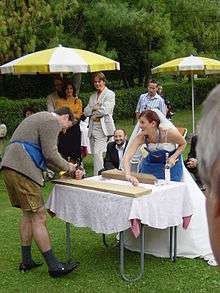Nagelbalken
Nagelbalken (German for nail beam) is a competition in which participants compete against each other to drive nails into a wooden beam. It can be found as a game of leisure at events and festivals, often for children and as a wedding custom.

History
According to Florian Dering, a museologist at the Munich Stadtmuseum, the nail beam game as folk amusement has been around since the 1920s.[1] This driving of nails into dimensional lumber has been used by showmen and charities to raise money, and also at weddings to have the newly married couple show their skills to the audience.
Dering reports a series of administrative regulations: the vertical cross-section of the plank should be at least 12 cm by 12 cm, and have no knots or protruding branches. Several hammers are used, each having a weight of at least 400 g and a handle length of at least 30 cm. The nails provided should have a round (but not smooth) head, and be at least two inches long. The nail bar is usually mounted at table height and secured to sawhorses by way of screw clamps. Rarely, a tree trunk is used in place of the wooden beam[2] the look of which was first used in the 1950s[3] and signifies a particular brand of the competition[4].
Competitive nailing can be a solo game[5][6]. However, the most common form is as a competition between several individuals, the winner of which gets a prize[7].
For Expo 2000, the Bundesanstalt für Arbeitsschutz und Arbeitsmedizin in Dortmund presented the Exhibition Of The Labor World to demonstrate different aspects of workplace security.[8] A Nagelbalken area was provided to demonstrate a person's physical competence.[9] Among many other things at the exhibition, the "Living And Working World" area in which the nail bar appeared dealt with the intellectual, psychological, physical, and social competence of people, which was implemented scenographically in four so-called "elementary spaces": four cubic, monomaterially formed spaces that were meant to arouse the senses by way of light, sounds, artistic ciphers, and smells.
Similar customs
Craftsmen in German-speaking countries have driven nails into certain wooden shapes for luck for centuries, as in the case of the Stock im Eisen in Vienna, Austria. This art was used as a fund-raising tool during the First World War, when the craft was adapted as a means of gathering donations for war-time charities, in the form of Nail Men. For a fee, a single nail could be partially driven into the figure. When completed, the figure would be transformed from wood to metal.
References
- Dering, Florian (1986). Volksbelustigungen: eine bildreiche Kulturgeschichte von den Fahr-, Belustigungs- und Geschicklichkeitsgeschäften der Schausteller vom 18. Jahrhundert bis zur Gegenwart (in German). F. Greno. ISBN 978-3-89190-005-5.
- Ericson, Randy (2001-09-29). "Autumn sun taps Oktoberfest festivities". Lacrosse Tribune. Retrieved 6 September 2018.
- "Hammerschlagen, History". Hammer-Schlagen. Retrieved 9 November 2018.
- "Don't get hammered over Hammer-Schlagen". postbulletin.com. Post Bulletin. Retrieved 1 August 2019.
- Hansen Buildings Channel (5 March 2012). "2012 NFBA Nail Pounding Contest". youtube.com. YouTube. Retrieved 15 July 2019.
- Maze Nailes (12 March 2015). "2015 NFBA nail pounding competition". youtube.com. YouTube. Retrieved 15 July 2019.
- Lindsay, Britt (1 November 2000). "Dead Games". CityPages.com. CityPages. Retrieved 15 July 2019.
- Gerhard Kilger, "Das szenografische Konzept der DASA", in: DASA – Arbeitswelt Ausstellung, Kolloquium 2000: Szenografie in Ausstellungen und Museen (pdf) (in German)
- .Kilger, Gerhard; Bieneck, Hans-Jürgen (2002). Neue Qualitèat der Arbeit: wie wir morgen arbeiten werden. Campus Verlag. p. 41. ISBN 978-3-593-37161-0.
Further reading
- Wulf, Christoph; Althans, Birgit; Audehm, Kathrin; Bausch, Constanze; Jörissen, Benjamin; Göhlich, Michael; Zirfas, Jörg (2004). Bildung Im Ritual: Schule, Familie, Jugend, Medien (in German). VS Verlag für Sozialw. p. 75. ISBN 978-3-8100-4090-9.
External links
- Helge Normann, "Das Geheimnis des Nagelbalkens", Wochenspiegel, 26 June 2010 (with video) (in German)
- Postenzettel (scorecard) for a Nagelbalken contest (PDF) (in German)